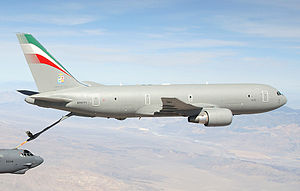Boeing KC-46
| KC-46 | |
|---|---|
| The KC-46A will be externally similar to this Italian Air Force KC-767A | |
| Role | Air-to-air tanker |
| Manufacturer | Boeing |
| Primary user | United States Air Force |
| Developed from | Boeing KC-767 |
The Boeing KC-46 is a military
Development
Background
The
Despite several nations leasing military aircraft, there was criticism. U.S. Senator
Then in December 2003, the Pentagon announced the project was to be frozen while an investigation of allegations of corruption by one of its former procurement staffers.
USAF KC-X Program
In 2006 the USAF released a
In late January 2007 the USAF issued the KC-X Aerial Refueling Aircraft Request for Proposal. The RFP called for 179 (4 system development and demonstration and 175 production) tankers, in a contract worth an estimated US$40 billion. However, Northrop and EADS expressed their displeasure at how the RFP was structured and threatened to withdraw, leaving only Boeing to offer an aircraft.
On 12 February 2007, Boeing announced it was offering the KC-767 Advanced Tanker for the KC-X Tanker competition. Boeing stated that for KC-X's requirements, the KC-767 was a better fit than the KC-777. On 11 April 2007, Boeing submitted its KC-767 tanker proposal to U.S. Air Force. The KC-767 Advanced Tanker offered for this KC-X round was based on the in-development 767-200LRF (Long Range Freighter), rather than the -200ER that Italian and Japanese KC-767 aircraft are based, differing by combining the -200ER fuselage, -300F wing, gear, cargo door and floor, -400ER digital flightdeck and flaps, uprated engines, and "sixth-generation" fly-by-wire boom. The KC-767 has
Boeing submitted the final version of its proposal on 3 January 2008. On 29 February 2008, the DoD chose the Northrop Grumman/EADS KC-30, now officially designated the
On 24 September 2009, the USAF began the first steps in the new round of bids, with a clearer set of criteria, including reducing the number of requirements from 800 to 373 in an attempt to simplify the process and allow a more objective decision to be made. On 4 March 2010, Boeing announced it will bid the KC-767 tanker for the new KC-X round. EADS announced in April 2010 it would submit a tanker bid without Northrop Grumman as a U.S. partner. Boeing submitted its KC-767 "NewGen Tanker" bid on 9 July 2010. The company submitted a revised bid on 10 February 2011.
On 24 February 2011, the Air Force announced the selection of Boeing's KC-767. The aircraft will receive the designation KC-46A. Boeing was also awarded a development contract for the tanker. The contract calls for Boeing to complete, and deliver 18 initial operational KC-46 tankers by 2017. Boeing's "NewGen Tanker" is based on the 767-200 with an improved version of the KC-10 refueling boom, and cockpit displays from the 787.
Variants
- KC-46A
Operators
Specifications
Specifications for KC-767 Advanced Tanker (767-200LRF based).
Data from KC-767A, KC-767 Advanced Boeing 767-200ER specifications
General characteristics
Performance
See also
Related development
Comparable aircraft
References
External links
Retrieved from : http://en.wikipedia.org/wiki/Boeing_KC-46
